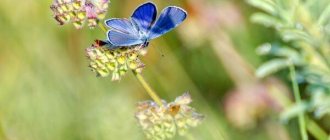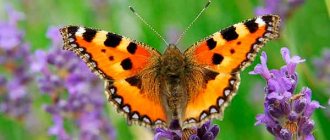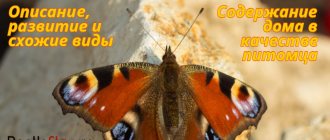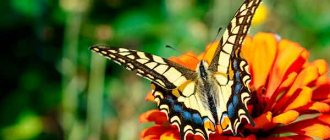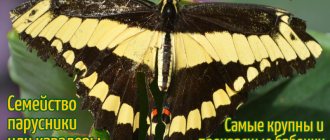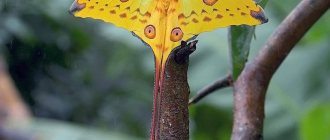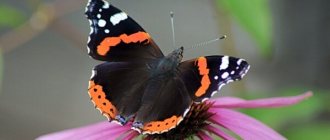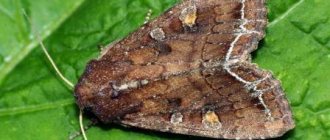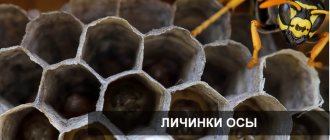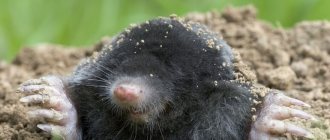- Wild animals
- >>
- Insects
Apollo is an incredibly beautiful and unique butterfly. In general, in terms of its external characteristics, it is no different from other species of the order Lepidoptera. The insect differs only in its unique color. In general, butterflies are very unusual animals. Many children love to catch them for fun, but it should be remembered that this can become a threat to her life. A person can easily accidentally damage an insect’s wings, which will subsequently lead to the inability to fly.
In this article:
|
Origin of the species and description
Photo: Apollo
Apollo itself is a very unusual name for a butterfly. It is not difficult to guess that the specific name was given to her in honor of the Greek god, who was the son of Zeus and Leto, the brother of Artemis and personified beauty with light.
As noted earlier, Apollo is not very different from lepidoptera in its size. The front wing has an average length of 37 to 40 millimeters. The span of both wings is usually between 75 and 80 millimeters. An adult caterpillar can reach a size of 5 centimeters before the cocoon stage.
Interesting fact: the male is smaller in size than the female. The female individual reaches from 83 to 86 millimeters
This species is almost the most recognizable among butterflies in all of Europe. It is the largest Parnassius of its kind.
Subspecies
The subspecies democratus (Krulikowsky, 1906) lives in the European part of Russia and the Middle Urals. In the forest-steppe of Western Siberia, you can find representatives of the subspecies meinhardi (Sheljuzhko, 1924) - very large, with large black and red spots on the milky white background of the wings in males, and in a coating of black scales - in females. The subspecies carpathicus occurs in the Carpathians (Rebel et Rogenhofer, 1892). In the foothills of the Middle and Southern Urals - limicola (Stichel, 1906), individuals of which are also very large, and the wings of females have a yellowish tint. The subspecies ciscaucasicus (Sheljuzhko, 1924) is widespread in the Greater Caucasus. The subspecies breitfussi (Bryk, 1914) is known from several specimens from the Crimea. In Altai, the subspecies alpherakyi (Krulikowsky, 1906) is distinguished. In the Sayan Mountains and Cisbaikalia, the subspecies sibiricus (Nordmann, 1851) is found, and in the eastern part of Siberia, the Baikal region and Mongolia - hesebolus (Nordmann, 1851), with snow-white wings with small black and red spots. The subspecies merzbacheri lives in Kyrgyzstan. Several subspecies of Apollo have been identified in the Pyrenees and the Alps.
Appearance and features
Photo: Apollo
Apollo is a butterfly with an unusual appearance and its own characteristics. The insect's wings are predominantly white. Sometimes they take on a soft creamy tint. Along the edges of the wings on the outer side you can see a wide stripe, on which there are white spots, which merge into a narrow stripe closer to the body. The number of these same spots is no more than 10, unless Apollo has any deviations. 5 of them are black, which are located on the upper wings, and 5 more red appear on the lower wings, which in turn have a rounded shape.
The Apollo has a black club on its antennae, which is not a rare occurrence for butterflies in general. The insect has smooth large eyes with small tubercles on which small bristles grow. Apollo's chest and abdomen are also covered with small silvery hairs. This species has pronounced sexual dimorphism. Females look much brighter and more impressive when compared with males. Insects that have recently left their pupa have a yellowish color on their wings.
During the caterpillar stage, Apollo is black with a number of white spots. Tufts of black hairs are also located throughout the body. In the adult stage, she develops blue warts and two red-orange spots.
Hebe the Bear
The she-bear Hebe lives in the steppe zone of our country. The wingspan of this butterfly reaches 55 millimeters. Their forewings are light, have black spots at the outer edge, and in the center there are 3 narrow black bands. The hind wings are reddish with black spots. These are night butterflies. They fly from May to July.
There is an opinion that the thick “fur” of the caterpillars helps them insulate themselves on cold nights. In any case, the butterflies were called “bears” for this thick hair covering of their caterpillars. Warty hairy bear caterpillars feed on a wide range of host plants, but they are especially fond of a variety of grasses.
Among the bears there are pests - for example, the American white butterfly Hyphantria cunea. Young caterpillars of the American white butterfly build a web nest and live together in it. During the day, the caterpillars leave the nest and eat leaves, and in the evening they return to it and spend the night together. Having matured, the caterpillars leave their “native nest” and live alone, and then pupate.
Caterpillars of the bear Spilarctia imperialis also live in colonies, constructing a common web nest. This helps protect against many non-specific predators - not just any insect will get into the thick of the web. But the ground beetle Parena perforata lives right in these nests. More precisely, its larvae live in the nest and feed to their heart's content without leaving the nests of these caterpillars. The only thing that limits the larva is the size of the caterpillar: small ground beetle larvae cannot cope with a hefty caterpillar and are forced to make do with small caterpillars.
The Kaya bear is one of the most common in our country; it is distributed from the European part of Russia to Siberia and the Far East. This relatively large butterfly reaches 80 mm in wingspan. The butterflies are found in July-August and their wings vary in colour, but are usually brown with a yellow and white pattern - a good example of distinct colouration. The hind wings and abdomen are brick red with shiny black spots. An alarmed female bear immediately opens her “camouflage” on her front wings, showing black or blue eye-shaped spots on her red hind wings, and immediately shoots a toxin from the glands located in her abdomen at the enemy struck by her red underwear. The caterpillars, like most bears, feed on herbaceous plants, and also on honeysuckle, mountain ash, willow, and can eat raspberries and apple trees.
It is known that many butterflies (including bears) hear well. Between the chest and abdomen, bear butterflies have a tympanic organ that hears ultrasound in the range of 3-100 kHz. Thanks to this organ, the butterfly hears the ultrasonic cry of the bat, which is tracking it. After this, he performs an anti-mouse maneuver, falls with a turn, sits down and waits until the danger has passed.
Ursa bears are famous as the most talkative family of butterflies. Indeed, many of them make a variety of sounds. At the same time, some bears have a perfect sound apparatus (like cicadas): the timbal plates, sharply returning to their place after the muscles change their curvature, emit a loud sound. The bear butterfly locates the bat and can communicate with other individuals of its species. Some female bears can emit sound using special “castanets,” which are dense chitinous plates on the edges of their hind wings. When the wings are brought together, the plates hit each other and click. Moreover, the chamber under the folded wings serves as a resonator, amplifying the sound.
Some female bears were not satisfied with passive sound defense (evading encounters with a bat), but themselves went on the offensive: Cycnia tenera produces ultrasonic clicks of considerable force (“ticks”), which prevent bats from finding their direction. Other mother bears are inedible to bats. And in order to reduce the number of mutually unpleasant conflicts, mother bears, in response to the “hunting howl” of a bat, emit identification ultrasonic signals that allow them to be distinguished from other edible butterflies - something like “I am completely inedible, and you know it.” This signal is “read” by the bat as an indication that the object is inedible.
It is less known that butterfly caterpillars also hear and this is very beneficial for them. Many wasps, such as ammophila wasps, hunt butterfly caterpillars to feed their larvae. So, they track caterpillars by smell - they “sniff out” the caterpillar along the trail in the grass forest. And the caterpillar hears the wasp: it perceives its buzzing and hides - it freezes or falls from the blade of grass. True, she can hear it from a maximum of ten centimeters away, but sometimes this even saves the caterpillar’s life - how come the winged huntress hasn’t yet seen the fat caterpillar’s body, still wandering between the stems?
Where does Apollo live?
Photo: Apollo
This unique butterfly can be found on the plains of Europe. As its habitat, it often chooses edges and large clearings in forest types such as pine, pine-oak and deciduous. These places should warm up well, since for Apollo the sun's rays are a very important aspect in his life. In Europe, this species can also be found in Russia.
Despite his love for forest edges and clearings, Apollo prefers to settle in the mountains. There the butterfly can be found in pine forests located near mountain rivers and streams. Sometimes this species can reach loaches. From time to time, Apollo can be found in subalpine meadows and flowering mountain slopes, but at an altitude of no more than 2500 meters above sea level.
If we talk about the countries where this species lives, it is necessary first of all to note the most densely populated geographical areas:
- Norway
- Sweden
- Finland
- France
- Ukraine and others
On the territory of Russia, Apollo can be found in Smolensk, Moscow, Yaroslavl and several other regions.
Limiting factors
Butterflies are very attached to their habitats. They make no attempt to find comfortable areas to live, moving long distances. A sedentary lifestyle negatively affects the number of insects. The destruction of natural biotopes leads to the death of Apollos. Among the factors that worsen living conditions:
- grass and bushes have fallen;
- trampling of meadows and clearings by cattle;
- plowing of land;
- overgrowing of wastelands with trees.
One of the reasons for the mass death of insects is global warming. An increase in air temperature in winter leads to premature hatching of caterpillars from eggs. The emerging larvae have nothing to eat; they die from hunger and the next frost.
What does Apollo eat?
Photo: Apollo
The diet of a butterfly such as the Apollo is not very different from other representatives of similar winged insects. Their main diet is pollen, which they collect from various flowers while flying. Apollo prefers asteraceous plants, that is, thistle, ragwort, cornflower, cornflower, oregano, nogolovatia and a variety of types of clover. In search of food, this species is able to fly a very long distance, specifically about 5 kilometers per day.
Like all butterflies, the Apollo feeds thanks to its spiral-shaped proboscis, which can penetrate deep into the core of the plant. With its help, insects can easily get nectar from the flower they like. During the break between meals, the spiral-shaped proboscis is in a curled state.
This species at the caterpillar stage is particularly voracious. After hatching from the egg, the animal begins to search for food. The caterpillar eats absolutely all the leaves of the plant it likes, and then immediately moves to a new one.
Dark side
According to myths, perhaps the main activity of the gods is fun. Apollo was considered one of their most sophisticated organizers. However, even this seemingly harmless deity has a dark side.
Apollo was considered the patron of the sciences and arts, especially music. The lyre is one of his attributes. But there is a curious myth according to which one of the satyrs (creatures whose upper body is human and the lower part of the body is goat) named Marsyas achieved such perfection in playing the flute that he dared to challenge Apollo to a musical duel. God accepted the challenge. His performance on the lyre delighted all the judges so much that they unanimously gave him the victory. However, this was not enough for the vengeful god. He ordered the unfortunate satyr to be caught and flayed alive.
Another unsightly act of Apollo was caused by such a noble feeling as sons' love. One woman named Niobe was extremely fertile and gave birth to 50 children. Proud of herself, she decided to mock Leto, reproaching her for being able to give birth to only a son and a daughter. Apollo and Artemis decided to stand up for their mother in a unique way. Armed with bows and arrows, they shot all of Niobe's children. The mother turned to stone out of grief.
It is assumed that cruelty was the main component of the image of Apollo in the archaic period. Evidence has been preserved according to which this god was remembered in those days as a demon of murder, death and destruction. Human sacrifices were even made in honor of Apollo.
Features of character and lifestyle
Photo: Apollo
Apollo 's lifestyle is almost no different from other representatives of butterflies. The main peak of its activity occurs during the daytime. In the evening it descends into the grass to spend the night and hide from possible enemies.
During the day, butterflies fly slowly, covering short distances from object to object. When we use the word object, we of course mean various flowering plants.
Females spend most of their lives in the grass. If they sense approaching danger, they can take off sharply and fly without stopping for a distance of up to 100 meters. If a butterfly is surprised by natural enemies during its sleep, it quickly turns over on its back and opens its wings, showing its red spots, thereby trying to scare away predators. She can also scrape her legs along the underside of her wings. This helps her create a hissing sound that is almost inaudible to humans.
Interesting Facts
- The butterfly got its name in honor of the Greek sun god Apollo. The beauty of the wings inspired biologists so much that they christened the insect with such a majestic name.
- Surprisingly, this species has poor flight abilities. When danger approaches, she tries to fly away as quickly as possible. However, this is not always possible. In this case, Apollo spreads his wings and begins to rub his paws against them. A hissing sound is created that scares predators.
- The Apollo butterfly prefers mountainous areas, which is not typical for insects. This species is well adapted to low temperatures. In addition, the insect can be found at high altitudes. For example, high-mountain species live in the Himalayas and feel great at an altitude of 6 km from sea level.
- The Arctic Apollo subspecies lives near an area where the snow never melts. For such a fragile insect this is a real miracle.
admiral butterfly - description, habitat, species
Social structure and reproduction
Photo: Apollo
The Apollo breeding season occurs in the summer season. Females are ready to mate immediately after emerging from the pupae, and males on the 2-3rd day. The male forms a sfargis with his reproductive apparatus on the female after mating - a chitinous appendage that does not allow her to mate with anyone else. Next, the female lays up to hundreds of white, round, 1.5 mm in diameter eggs, one at a time or in groups on or near different parts of the plant. From them hatch black caterpillars with tufts of long hair, colored with orange spots on the sides. They also have steel-blue warts on each segment and a reddish osmeterium, from which a repulsive odor is sprayed when threatened.
On clear days, adult caterpillars actively feed on the leaves of various types of sedum - this is their food plant. Depending on the terrain, the caterpillars can also feed on spiny grass. They do not stop eating until their outer shell becomes very dense and tight, then a molt occurs, repeating 5 times before the next stage.
The caterpillar often chews through the sedum, it falls to the ground and is completely eaten on the ground. This is where pupation occurs. This stage lasts about two weeks. The pupa reaches 18-24 mm in length and is at first light brown with translucent integuments and dark brown spiracles, and the very next day it darkens and becomes covered with a blue-powdery coating. This stage of immobility. After all this difficult journey, a beautiful Apollo butterfly is born from the pupa.
Damage caused by meadow moths
Meadow moths belong to a group of particularly dangerous pests; they cause huge losses to agriculture. At the same time, both adult individuals and caterpillars at any stage of development are dangerous. Meadow moth butterflies feed on nectar and compete with honey bees. It has been noted that where there are a large number of meadow moths, the collection of honey in apiaries is noticeably reduced.
But the greatest damage is caused by voracious caterpillars. They eat plant seedlings at the initial stage of development, entwine them with webs and turn them into skeletons. Older caterpillars completely destroy all vegetation in their path, leaving only cuttings. A large colony of caterpillars can eat up the entire crop in a garden in a couple of days.
The diet of the voracious caterpillars of meadow moths consists of 200 plants. Favorite delicacies include sugar beets and weeds. With the same pleasure they destroy sunflowers, hops, corn, vegetables, buckwheat, alfalfa, millet, legumes and clover.
Pests also cause damage to young tree seedlings. If there are approximately 6 meadow moth caterpillars on a sugar beet seedling, the yield drops by 50-60%. If there are about 20 caterpillars, then the crops can be destroyed in a few days. And if the weather is hot, pests can destroy the planting in just a few hours.
Outbreaks of mass appearances of meadow moths occur approximately once every 8-10 years. A huge number of caterpillars can crawl from one area to another, and at the same time destroy everything that they come across. Favorable conditions for mass reproduction of meadow moths are sufficient rainfall and a temperature of about 17 degrees. If the weather is dry, the population of meadow moths decreases sharply, and the butterflies become infertile.
If you find an error, please select a piece of text and press Ctrl+Enter
.
Moths belong to the insect family Lepidoptera, or Butterflies. One of the main ways to tell a butterfly from a moth is to watch how they fold their wings when they sit down to rest. Butterflies usually keep their wings folded in an elevated position, while moths spread their wings horizontally. Butterflies usually flutter in the air during the daytime, and moths fly in the evening and at night. They strive for the light that burns in the night. Therefore, you can often see moths flying into the window and circling around the light bulb. Typically, moths have camouflage markings on the upper side of their wings, as these moths usually sit with their wings spread out. At night, protective colors do not really help the caterpillar or moth. There are other differences: in butterflies, the antennae usually have a thickening at the end, while in moths, the antennae are straight or even shaggy. In addition, the bodies of moths are thicker than those of butterflies and are more densely covered with hairs.
different types
You can often see it fluttering over the crops, flying from bed to bed. However, despite its beauty, the meadow moth should be feared.
In fact, it is a dangerous garden pest that damages potatoes and all kinds of vegetable crops.
The meadow moth lives in the steppes and forest-steppes of southern Russia, in the Crimea, all the way to the Far East. This butterfly has a grayish-brown color with dark brown spots and a yellow stripe along the outer edge; the wings below are light gray or dirty yellow.
When a butterfly sits quietly, its folded wings look like a triangle. Its caterpillars are greenish-gray in color, have a dark stripe along the back and several side stripes, and the head is black with a clear pattern.
Overwintering of caterpillars occurs in cocoons, in the surface layer of the earth. In spring, caterpillars pupate. Butterflies fly out of cocoons in the south with the onset of heat in late April - early May. In the central regions of Russia in the second and third ten days of May.
Natural enemies of Apollo
Photo: Apollo
Apollo, like other butterflies, has many natural enemies. Representatives of fauna such as birds, wasps, mantises, frogs and dragonflies are considered especially dangerous for them. From time to time, this butterfly is also not averse to feasting on several species of spiders, lizards, hedgehogs and rodents. The main part of these same enemies can take Apollo by surprise at night while he is resting or during the day, when the insect is perched on a flowering plant.
Of course, we cannot forget about such an enemy as man. As we noted earlier, young children catch butterflies for fun. This can directly disrupt their livelihoods. Even after a person has released an insect from his net, it may simply not take off, as damage to vital organs could occur.
Diet
The distribution of Apollo is tied to food plants. Adults feed on flower nectar. Butterflies visit the white buds of sedum (hare cabbage), purple heads of clover, milk thistle, pink umbrellas of oregano, and blue baskets of cornflower.
Large insects require a lot of food. Apollos find the most food on sunny edges and mixed-grass meadows. The number of eggs laid by the female depends on good nutrition.
The main plant that the caterpillar feeds on are different varieties of sedum (white, large, purple, Eversa, caustic, tenacious), juveniles.
Population and species status
Photo: Apollo
The Apollo butterfly population is going through hard times. This species is very vulnerable. Its numbers are declining catastrophically quickly every year. Previously, these beautiful lepidopteran insects lived in many European countries, but at the moment they are no longer found anywhere.
Now the majority of populations can be found in Eastern Fennoxandia. Unfortunately, at the moment the species is on the verge of extinction and has become very rare in those places where previously this beautiful butterfly could be found without much difficulty. The reason for this situation was frequent trampling, burning, plowing near populated areas, where the Apollo butterfly usually lives and reproduces. They are almost not inclined to migrate, so they died, having almost no chance of preserving the species living in the territory that was destroyed. Therefore, the more you disturb and interfere with the butterfly’s habitat, the more their numbers decrease.
It is necessary to take measures to help prevent such a sharp decline in the number of the Apollo butterfly. We’ll talk about security measures in the next section.
Notes
- ↑ Day butterflies (Hesperioidea and Papilionoidea, Lepidoptera) of Eastern Europe. CD identifier, database and Lysandra software package. I. G. Plyushch, D. V. Morgun, K. E. Dovgailo, N. I. Rubin, I. A. Solodovnikov. Minsk, 2005
- K. Lampert
Atlas of butterflies and caterpillars. - Minsk: Harvest, 2003. - 735 p. — 5000 copies. — ISBN 985-13-1664-4 - Reichholf-Rim H. Butterflies. M.: Astrel, 2002
- Animal life according to A.E. Brem. T.2: Arthropods. M.: Uchpedgiz RSFSR, 1941
- Korshunov, 2002.
- Pekarsky, P.: 1953, Parnassius apollo L. in den Karpaten. Zeitschrift der Wiener Entomologisches Gesellschaft,
| common Apollo species in Russia is on the verge of extinction and is listed in the Red Book of Russia |
Parnassius apollo Linnaeus, 1758
Order Lepidoptera - Lepidoptera
Family Papilionidae - Swallowtails
| Common Apollo | Area |
A European-Asian species, a representative of a large genus, most species of which are distributed in Asia. Lives in the Caucasus, Transcaucasia, Kazakhstan, the Urals, Western Siberia, including Altai. Exotic appearance, widely used in collecting.
Status.
II category. With this category it is recommended for inclusion in the Red Book of the Russian Federation.
Brief description of appearance in adult stage
. The largest representative of the genus Parnassius. The length of the front wing is 40-45 mm. The general color of the wings is white or cream; the wings of females at the outer edge are poorly pollinated and therefore translucent. There are five black spots on the front wings, and five red spots on the hind wings with a white center and a black outer edge. The outer edges of the wings above do not have a complete transverse row of black spots between the veins. The body of butterflies is significantly pubescent.
Spreading.
Found on the Cherginsky, Seminsky, Katunsky, Severo-Chuisky, Terekhtinsky, Iolgo ridges; Saylyugem, Kuraisky and Yuzhno-Chuysky (southern macroslope), on the coast of Lake Teletskoye (Chiri cordon).
Habitats.
On the Katunsky ridge along the southern and southeastern slopes it rises to heights of 1500 m. In the northern part of Altai it is found in mountain steppe meadows with bedrock outcrops and along the edges of pine-birch forests bordering steppe meadows. In Central and South-Eastern Altai it occupies a variety of open and semi-open landscapes from mid-mountains to high mountains.
Number and trend of its change
. In Northern Altai, in July, from rare to common on wetted motley meadows and along the edges of pine-birch forests bordering steppe meadows; in August, rare everywhere. In Central Altai in July-August, the number of Apollo is relatively stable, common in open landscapes, and from rare to common in other landscapes.
Limiting factors.
Deterioration or complete destruction of habitats due to economic activities.
Features of biology.
A sedentary species, incapable of migration. Occurs locally. Gives one generation per year. The flight of butterflies is observed in June-August, in some years - in the first half of September. Butterflies feed on skerda and grasshopper. Egg laying and feeding of caterpillars takes place on sedum. The formed caterpillars overwinter in the eggs.
Breeding.
No data.
Security measures taken
. It lives on the territory of the Altai and Katunsky nature reserves and is included in the Convention on International Trade in Endangered Species of Wild Fauna and Flora.
Necessary security measures.
It is necessary to identify specific habitats of the species in order to clarify its range in Altai. A complete ban on fishing for commercial purposes throughout the republic.
Information sources.
1. Standel, 1957; 2. Kosterin, 1994; 3. Malkov, 1987; 4. Malkov et al., 1995.
Compiled by:
Yu.P.Malkov, O.V.Pyankova.
Preservation
This species is of interest to entomologists due to the diversity of subspecies, often only limited to a specific valley in the Alps. The beautiful Apollo butterfly has long been prized by collectors who strive to own as many varieties as possible. While overharvesting is believed to have caused populations to decrease in some areas, such as in Spain and Italy, habitat change is thought to be a much more significant threat to the survival of these species. Conifer plantations, succession of suitable habitat to forested areas, agriculture and urbanization have all reduced the habitat of the Apollo butterfly. Climate change and acid rain have also been implicated in this decline of Fennoscandia species. Additionally, motor vehicles have been cited as the cause of Apollo butterfly mortalities; vehicles on the motorway system near Bozen in South Tyrol, Italy are said to have nearly wiped out the Apollo race.
In Finland, Apollo was one of the first insect species to be declared endangered. Apollo's population in Finland and Sweden decreased dramatically during the 1950s. The reason for this is not known, but it is usually thought to be due to illness. In Sweden, it is now limited to areas that have limestone in the ground, suggesting that the decrease could hypothetically be related to acid rain.
Laws exist to protect the Apollo butterfly in many countries. Apollo is on the IUCN Red List of Threatened Animals in Appendix II of the CITES convention. and is mentioned in Annex IV of the Habitats Directive. It is protected in other states: the Principality of Liechtenstein, the Czech Republic (as a critically endangered species in the Czech Code, Implementation Decree, Coll. No. 395/1992., and Coll. No. 175/2006.), Turkey and Poland.
However, these laws focus on protecting people, not their environment, and so may do little to mitigate that population's biggest threat. Luckily, there are many projects definitely working to save this vulnerable insect
A conservation program at Pieniny National Park saved a subspecies of the Apollo butterfly, which had declined to just 20 individuals in the early 1990s through a combination of captive breeding and habitat conservation. In southwestern Germany, conservationists are working with shepherds to ensure favorable conditions for the butterfly, which shares its field habitat with sheep. For example, grazing periods were moved to avoid the larval stage of the Apollo butterfly, which is vulnerable to being trampled.
Apollo butterflies have many subspecies throughout the world, and some European subspecies are showing alarming declines in numbers. This is mainly caused by habitat destruction, air pollution affecting the insect's host plants and butterfly collectors. The Apollo butterfly is also more vulnerable to predators since it spends two years as a caterpillar.
On Mount Parnassus
According to legend, when spring comes to earth, the Greek god Apollo goes to Mount Parnassus, next to which the Kastal spring gurgles. There he leads round dances with the eternally young muses - the daughters of Zeus: Thalia, Melpomene, Euterpe, Erato, Clio, Terpsichore, Urania, Calliope and Polyhymnia. All of them are patrons of various arts.
The god Apollo and the muses together form a divine ensemble in which the girls sing, and he accompanies their singing by playing his golden lyre. In those moments when their choir is heard, nature falls silent to enjoy the divine sounds. Zeus himself at this time becomes meek, and the lightning in his hands fades away, and the bloody god Ares forgets about the war. Peace and tranquility will then reign on Olympus.
Atonement
After the god Apollo shed the blood of Python, by the decision of Zeus he had to cleanse himself of this sin and atone for it. The young man was banished to Thessaly, whose king at that time was Admetus. Apollo had to become a shepherd in order to achieve redemption through simple hard work. He humbly tended the royal flocks and sometimes, right in the middle of the pasture, amused himself by playing a simple reed flute.
His music was so wonderful that even wild animals came out of the forest to listen to it. When Apollo, the god of ancient Greece, played music, fierce lions and predatory panthers walked peacefully among his herd along with deer and chamois. Joy and peace reigned all around. Prosperity came to the house of King Admet. His horses and gardens became the best in Thessaly. Apollo also helped Admetus in love. He endowed the king with enormous strength, thanks to which he was able to harness a lion to his chariot. This condition was set by the father of Admet’s beloved Alkesta. Apollo served as a shepherd for eight years. Having completely atoned for his sin, he returned to Delphi.
